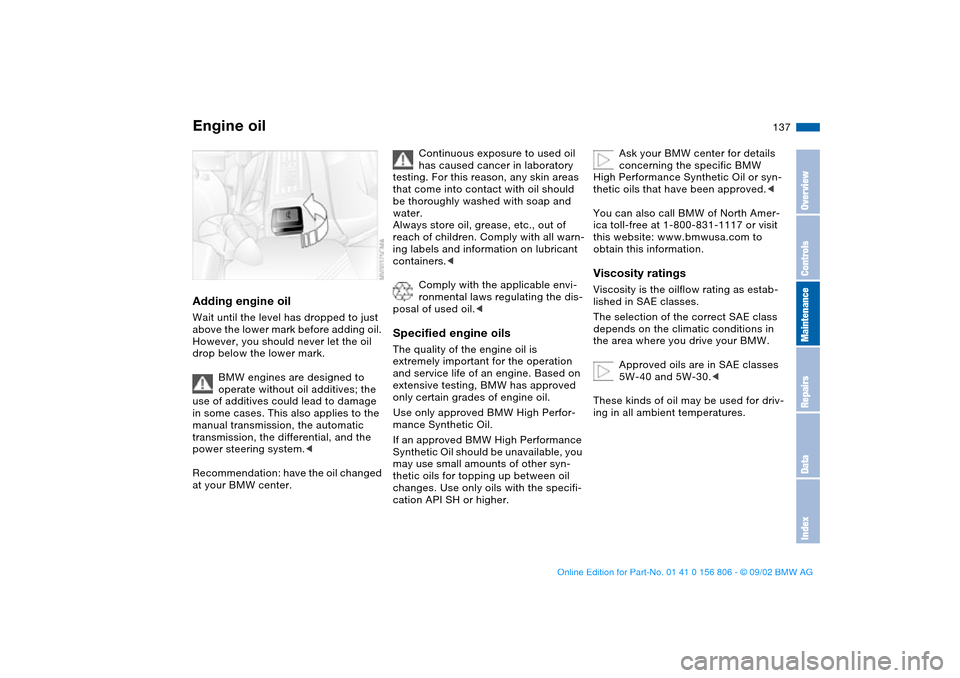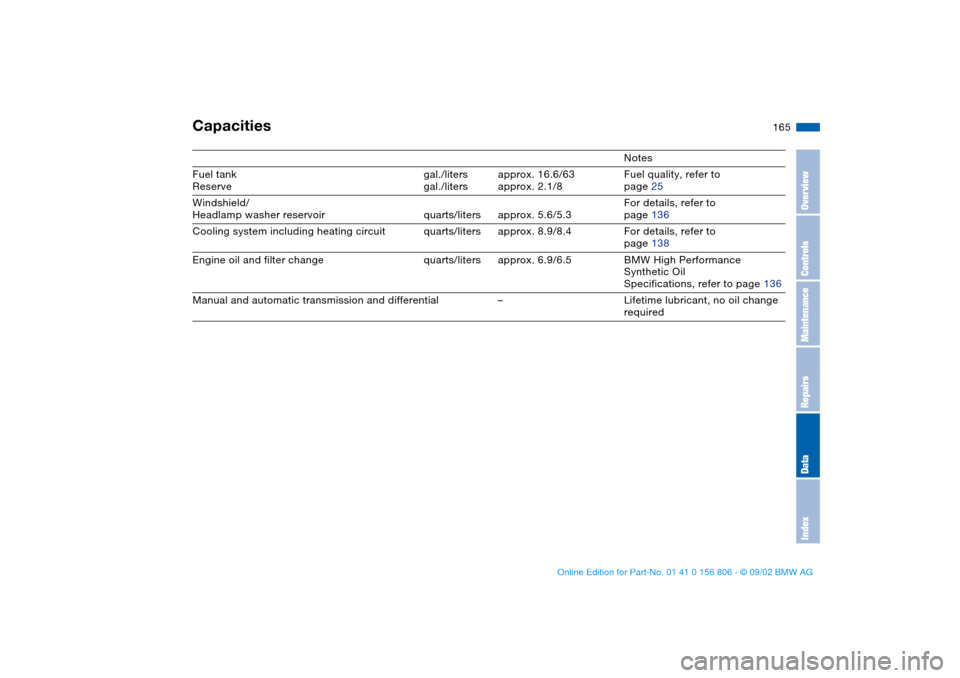2003 BMW 330Ci CONVERTIBLE differential
[x] Cancel search: differentialPage 122 of 178

122Special operating instructions
Break-in proceduresTo ensure that your vehicle continues to
provide maximum economy throughout
an extended service life, we request
that you devote careful attention to the
following instructions.Engine and differentialThe first 1,250 miles/2,000 km:
Attempt to constantly vary both vehicle
and engine speeds during these initial
miles while remembering to avoid
engine speeds in excess of 4,500 rpm
and/or vehicle speeds of over
100 mph / 160 km/h:
Always obey all official speed limits.
Refrain from using full throttle and avoid
pressing the accelerator beyond the
kickdown point.
You can then proceed to increase both
engine and vehicle speeds once the ini-
tial 1,250 miles/2,000 km have elapsed.
Please remember to observe the same
break-in procedures if either the engine
or the differential should have to be
replaced later in the course of the vehi-
cle's service life.
TiresOwing to technical factors associated
with their manufacture, tires do not
achieve their full traction potential until
an initial break-in period has elapsed.
We thus ask you to drive with extra care
during the first 200 miles/300 km.
Always obey all official speed limits.
When the vehicle is operated on
wet or slushy roads, a wedge of
water may form between the tire and
the road surface. This phenomenon is
referred to as hydroplaning, and can
lead to partial or complete loss of trac-
tion, vehicle control and braking effec-
tiveness. Reduce your speed on wet
roads.
achieve the optimal pad-surface and
wear patterns required for trouble-free
operation and an extended service life
later on.
To break in the separate parking brake
drums, apply the parking brake lightly
when coasting to a standstill – at a traf-
fic signal, for instance; use caution to
avoid posing a danger to other road
users.
You can prevent corrosion in the drums
by periodically repeating this proce-
dure.
The brake lamps do not come on
when the parking brake is set.
Vacuum for the brake system servo unit
on your BMW is available only when the
engine is running. When you move the
vehicle with the engine off – when tow-
ing, for example – substantially higher
levels of pedal force will be required to
brake the vehicle.
optimum efficiency. Remember to
engage the clutch carefully during this
initial period.
handbook.book Page 122 Wednesday, July 31, 2002 9:29 AM
Page 137 of 178

137
Adding engine oilWait until the level has dropped to just
above the lower mark before adding oil.
However, you should never let the oil
drop below the lower mark.
BMW engines are designed to
operate without oil additives; the
use of additives could lead to damage
in some cases. This also applies to the
manual transmission, the automatic
transmission, the differential, and the
power steering system.<
Recommendation: have the oil changed
at your BMW center.
Continuous exposure to used oil
has caused cancer in laboratory
testing. For this reason, any skin areas
that come into contact with oil should
be thoroughly washed with soap and
water.
Always store oil, grease, etc., out of
reach of children. Comply with all warn-
ing labels and information on lubricant
containers.<
Comply with the applicable envi-
ronmental laws regulating the dis-
posal of used oil.<
Specified engine oilsThe quality of the engine oil is
extremely important for the operation
and service life of an engine. Based on
extensive testing, BMW has approved
only certain grades of engine oil.
Use only approved BMW High Perfor-
mance Synthetic Oil.
If an approved BMW High Performance
Synthetic Oil should be unavailable, you
may use small amounts of other syn-
thetic oils for topping up between oil
changes. Use only oils with the specifi-
cation API SH or higher.
Ask your BMW center for details
concerning the specific BMW
High Performance Synthetic Oil or syn-
thetic oils that have been approved.<
You can also call BMW of North Amer-
ica toll-free at 1-800-831-1117 or visit
this website: www.bmwusa.com to
obtain this information.
Viscosity ratingsViscosity is the oilflow rating as estab-
lished in SAE classes.
The selection of the correct SAE class
depends on the climatic conditions in
the area where you drive your BMW.
Approved oils are in SAE classes
5W-40 and 5W-30.<
These kinds of oil may be used for driv-
ing in all ambient temperatures.
Engine oil
OverviewControlsMaintenanceRepairsDataIndex
handbook.book Page 137 Wednesday, July 31, 2002 9:29 AM
Page 165 of 178

165
Capacities
Notes
Fuel tank
Reservegal./liters
gal./litersapprox. 16.6/63
approx. 2.1/8Fuel quality, refer to
page 25
Windshield/
Headlamp washer reservoir quarts/liters approx. 5.6/5.3For details, refer to
page 136
Cooling system including heating circuit quarts/liters approx. 8.9/8.4 For details, refer to
page 138
Engine oil and filter change quarts/liters approx. 6.9/6.5 BMW High Performance
Synthetic Oil
Specifications, refer to page 136
Manual and automatic transmission and differential – Lifetime lubricant, no oil change
required
OverviewControlsMaintenanceRepairsDataIndex
handbook.book Page 165 Wednesday, July 31, 2002 9:29 AM
Page 168 of 178

Everything from A to ZA
ABS Antilock Brake
System 123
indicator lamp 19
Accessories 5
Activated-charcoal filter 108
ADB Automatic Differential
Braking 88
Adding brake fluid 134, 139
Air conditioning
100, 102, 106
Air distribution 102
automatic 106
individual 106
Air nozzles 100, 104
Air outlets 100, 104
Air pressure 127
check 25
Air supply 102, 106
Air supply/Blower
recirculated-air mode 107
Airbags 61
warning lamp 18
Alarm system 38
avoiding false alarm 39
indicator lamp 39
interior protection 38
tilt alarm sensor 38
Antifreeze 138
Antilock Brake System
(ABS) 123
indicator lamp 19Anti-theft system 30, 38
Armrest 112
ASC+T Automatic Stability
Control plus Traction 88
indicator lamp 19
Ashtray
front 113
rear 114
AUC Automatic recircu-
lated-air control 107
Automatic car wash, refer to
the Caring for your vehicle
brochure
Automatic climate
control 104
Automatic cruise control 79
Automatic curb monitor 58
Automatic Differential Brak-
ing (ADB) 88
Automatic dimming, interior
rearview mirror 60
Automatic headlamp
control 96
Automatic recirculated-air
control (AUC) 107
Automatic Stability Control
plus Traction (ASC+T) 88
indicator lamp 19
Automatic transmission with
Steptronic 74
indicator lamps 19Auxiliary terminal for jump-
starting 134, 157
Average fuel
consumption 86
Average speed 86
Avoiding unintentional
alarms 39
Axle loads 164
B
Backrest
unlock 55
Backup lamps 73
replacing bulb 149
Battery 156
charge 156
charge current 18
charge indicator lamp 18
Belts 56
Beverage holder 113
Blower 100, 102, 106
BMW High Performance
Synthetic Oils 137
BMW Maintenance
System 140
BMW Universal
Transmitter 110
Bore 162
Bottle holder, see Beverage
holder 113
Brake
warning lamp 18Brake fluid level 124
warning lamp 18, 139
Brake hydraulics
warning lamp 18
Brake lamps
replacing bulb 149
Brake pads 124
indicator lamp 19
Brakes
driving notes 123
malfunctions 124
parking brake 72
Break-in procedures 122
Bulb, replacing 147
C
California Proposition
65 warning 141
Can holder, see Beverage
holder 113
Capacities 165
Car care, refer to Caring for
your vehicle brochure
Car radio
refer to the Owner's Man-
ual for Radio
Car telephone
refer to the separate
Owner's Manual
Car vacuum cleaner, con-
necting 114
handbook.book Page 168 Wednesday, July 31, 2002 9:29 AM